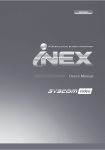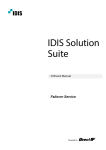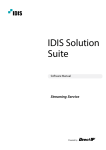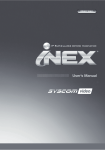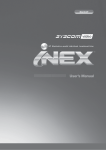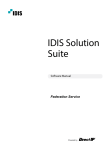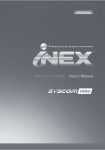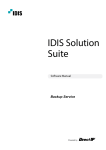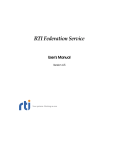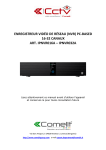Download warning
Transcript
Federation Server WARNING RISK OF ELECTRIC SHOCK DO NOT OPEN WARNING: TO REDUCE THE RISK OF ELECTRIC SHOCK, DO NOT REMOVE COVER (OR BACK). NO USER-SERVICEABLE PARTS INSIDE. REFER SERVICING TO QUALIFIED SERVICE PERSONNEL. The lightning flash with arrowhead symbol, within an equilateral triangle, is intended to alert the user to the presence of uninsulated "dangerous voltage" within the product's enclosure that may be of sufficient magnitude to constitute a risk of electric shock. The exclamation point within an equilateral triangle is intended to alert the user to the presence of important operating and maintenance (servicing) instructions in the literature accompanying the appliance. COMPLIANCE NOTICE OF FCC: THIS EQUIPMENT HAS BEEN TESTED AND FOUND TO COMPLY WITH THE LIMITS FOR A CLASS A DIGITAL DEVICE, PURSUANT TO PART 15 OF THE FCC RULES. THESE LIMITS ARE DESIGNED TO PROVIDE REASONABLE PROTECTION AGAINST HARMFUL INTERFERENCE WHEN THE EQUIPMENT IS OPERATED IN A COMMERCIAL ENVIRONMENT. THIS EQUIPMENT GENERATES, USES, AND CAN RADIATE RADIO FREQUENCY ENERGY AND IF NOT INSTALLED AND USED IN ACCORDANCE WITH THE INSTRUCTION MANUAL, MAY CAUSE HARMFUL INTERFERENCE TO RADIO COMMUNICATIONS. OPERATION OF THIS EQUIPMENT IN A RESIDENTIAL AREA IS LIKELY TO CAUSE HARMFUL INTERFERENCE, IN WHICH CASE USERS WILL BE REQUIRED TO CORRECT THE INTERFERENCE AT THEIR OWN EXPENSE. WARNING: CHANGES OR MODIFICATIONS NOT EXPRESSLY APPROVED BY THE PARTY RESPONSIBLE FOR COMPLIANCE COULD VOID THE USER’S AUTHORITY TO OPERATE THE EQUIPMENT. THIS CLASS OF DIGITAL APPARATUS MEETS ALL REQUIREMENTS OF THE CANADIAN INTERFERENCECAUSING EQUIPMENT REGULATIONS. The information in this manual is believed to be accurate as of the date of publication. We are not responsible for any problems resulting from the use thereof. The information contained herein is subject to change without notice. Revisions or new editions to this publication may be issued to incorporate such changes. The software included in this product contains some Open Sources. You may obtain the complete corresponding source code from us. See the Open Source Guide on the software CD (OpenSourceGuide\OpenSourceGuide.pdf) or as a printed document included along with the User's Manual. i User’s Manual Important Safeguards 1. Read Instructions All the safety and operating instructions should be read before the appliance is operated. 11. Overloading Do not overload wall outlets and extension cords as this can result in the risk of fire or electric shock. 2. Keep Instructions The safety and operating instructions should be kept for future reference. 12. Objects and Liquids Never push objects of any kind through openings of this equipment as they may touch dangerous voltage points or short out parts that could result in a fire or electric shock. Never spill liquid of any kind on the equipment. 3. Cleaning Unplug this equipment from the wall outlet before cleaning it. Do not use liquid aerosol cleaners. Use a damp soft cloth for cleaning. 4. Attachments Never add any attachments and/or equipment without the approval of the manufacturer as such additions may result in the risk of fire, electric shock or other personal injury. 5. Water and/or Moisture Do not use this equipment near water or in contact with water. 6. Accessories Do not place this equipment on an unstable cart, stand or table. The equipment may fall, causing serious injury to a child or adult, and serious damage to the equipment. Wall or shelf mounting should follow the manufacturer's instructions, and should use a mounting kit approved by the manufacturer. This equipment and cart combination should be moved with care. Quick stops, excessive force, and uneven surfaces may cause the equipment and cart combination to overturn. 7. Ventilation Slots and openings in the cabinet and the back or bottom are provided for ventilation, and to ensure reliable operation of the equipment and to protect it from overheating. These openings must not be blocked or covered. Do not block these openings or allow them to be blocked by placing the equipment on a bed, sofa, rug, or bookcase. Ensure that there is adequate ventilation and that the manufacturer’s instructions have been adhered to. 8. Power Sources This equipment should be operated only from the type of power source indicated on the marking label. If you are not sure of the type of power, please consult your equipment dealer or local power company. 9. Power Cords Operator or installer must remove power and other connections before handling the equipment. 10. Lightning For added protection for this equipment during a lightning storm, or when it is left unattended and unused for long periods of time, unplug it from the wall outlet and disconnect the antenna or cable system. This will prevent damage to the equipment due to lightning and power-line surges. 13. Servicing Do not attempt to service this equipment yourself. Refer all servicing to qualified service personnel. 14. Damage requiring Service Unplug this equipment from the wall outlet and refer servicing to qualified service personnel under the following conditions: A. When the power-supply cord or the plug has been damaged. B. If liquid is spilled, or objects have fallen into the equipment. C. If the equipment has been exposed to rain or water. D. If the equipment does not operate normally by following the operating instructions, adjust only those controls that are covered by the operating instructions as an improper adjustment of other controls may result in damage and will often require extensive work by a qualified technician to restore the equipment to its normal operation. E. If the equipment has been dropped, or the cabinet damaged. F. When the equipment exhibits a distinct change in performance — this indicates a need for service. 15. Replacement Parts When replacement parts are required, be sure the service technician has used replacement parts specified by the manufacturer or that have the same characteristics as the original part. Unauthorized substitutions may result in fire, electric shock or other hazards. 16. Safety Check Upon completion of any service or repairs to this equipment, ask the service technician to perform safety checks to determine that the equipment is in proper operating condition. 17. Field Installation This installation should be made by a qualified service person and should conform to all local codes. 18. Telnet Communication Cable Caution: To reduce the risk of fire, use only No. 26 AWG or larger telecommunication line cord. 19. Danger of explosion if battery is incorrectly replaced. Replace only with same or equivalent type recommended by manufacturer. Discard used batteries according to the manufacturer’s instruction. WEEE (Waste Electrical & Electronic Equipment) Correct Disposal of This Product (Applicable in the European Union and other European countries with separate collection systems) This marking shown on the product or its literature, indicates that it should not be disposed with other household wastes at the end of its working life. To prevent possible harm to the environment or human health from uncontrolled waste disposal, please separate this from other types of wastes and recycle it responsibly to promote the sustainable reuse of material resources. Household users should contact either the retailer where they purchased this product, or their local government office, for details of where and how they can take this item for environmentally safe recycling. Business users should contact their supplier and check the terms and conditions of the purchase contract. This product should not be mixed with other commercial wastes for disposal. ii Federation Server Table of Contents Chapter 1 — Introduction ............................................................................................ 1 1.1 Package Contents ............................................................................................. 1 1.2 System Diagram ................................................................................................ 1 1.3 Rear Panel ........................................................................................................ 2 1.4 Front Panel ........................................................................................................ 2 1.5 Tuning On/Off the System................................................................................. 3 Chapter 2 — Getting Started ....................................................................................... 5 2.1 Connecting ........................................................................................................ 5 2.2 System Setting .................................................................................................. 6 2.3 Registering Services ......................................................................................... 9 2.4 Live Video Monitoring...................................................................................... 11 2.5 Playing Recorded Video.................................................................................. 11 Chapter 3 — System Overview ................................................................................. 13 3.1 Service Manager ............................................................................................. 13 3.2 Setup ............................................................................................................... 13 3.3 Client ............................................................................................................... 14 Running Client Program Remotely ................................................................. 15 Chapter 4 — Upgrade ............................................................................................... 19 Remote Upgrade ............................................................................................. 19 Troubleshooting ......................................................................................................... 25 Specification .............................................................................................................. 27 iii User’s Manual iv Federation Server Chapter 1 — Introduction This manual describes operation of the federation server, which is designed to be used with NVRs (Network Video Recorders). The federation server allows you to monitor live video from devices (maximum 256 channels) registered on the NVRs (Network Video Recorders) and to play back recorded video saved in the NVRs (Network Video Recorders). NOTES: This product includes software developed by the OpenSSL Project for use in the OpenSSL Toolkit (http://www.openssl.org/). The software included in this product contains some Open Sources. You may obtain the complete corresponding source code from us. See the Open Source Guide on the software CD (OpenSourceGuide\ OpenSourceGuide.pdf) or as a printed document included along with the User's Manual. 1.1 Package Contents Installation CD User’s Manual WIBU-Key (USB Dongle) NOTES: If a WIBU-Key is disconnected from a federation server, the federation service will not operate properly. Stop running the federation service before connecting or disconnecting a WIBU-Key. 1.2 System Diagram 1 User’s Manual 1.3 Rear Panel ① Power In: Connect a power cord. ② USB Port: Connect USB devices or a WIBU-Key provided with the federation server. It is required to connect a WIBU-Key for the federation server system to operate properly. Stop running the federation service before connecting or disconnecting the WIBU-Key. ③ Network (RJ-45): Connect a Cat5 cable with an RJ-45 jack. ④ Audio In (mic): Connect a microphone. This is for two-way audio communication. ⑤ Audio Out (Line out): Connect a speaker. ⑥ Audio In (Line in): Connect a line-in device. This is for two-way audio communication. ⑦ DVI: Connect a PC monitor. Connect a monitor before turning on the system. Video might not be displayed on the monitor when connecting a monitor after turning on the system. ⑧ D-Sub: Connect a PC monitor. Connect a monitor before turning on the system. Video might not be displayed on the monitor when connecting a monitor after turning on the system. NOTE: The location of DVI and D-Sub connectors is subject to change without notice. 1.4 Front Panel ① Power Button: Turns on or off the system. ② Power LED: Is lit when the unit is turned on. ③ HDD LED: Flickers when the unit accesses to the hard disk drive. ④ DVD RW: Used to save the recorded data on the CD-RW or DVD RW media. 2 Federation Server ⑤ USB Port: Connects the USB devices or a WIBU-Key provided with the federation server. It is required to connect a WIBU-Key for the federation server system to operate properly. Stop running the federation service before connecting or disconnecting the WIBU-Key. NOTE: Windows may not operate properly when using the USB connectors on the front panel of the unit, depending on the model type of the USB device. In this case, connect the USB device after Windows boots properly or use the USB connectors located on the rear panel. 1.5 Tuning On/Off the System Pressing the power button on the front panel turn on the system and the SiRiS program runs. Clicking Shutdown under the System menu in the SiRiS Client program while the system turns on will ask you to confirm turning off the system and the system turns off when you confirm. Or pressing the power button on the front panel will shut down the system. NOTE: Connect a monitor before turning on the system. Video might not be displayed on the monitor when connecting a monitor after turning on the system. 3 User’s Manual 4 Federation Server Chapter 2 — Getting Started 2.1 Connecting The SiRiS program runs automatically when the federation server turns on. You are required to log in to the federation server as follows. Login Go to the System Menu at the top left corner of the screen and click Login. Site Name: Select Local Host to connect to the current federation server. You can add other federation services to the list or modify information about the federation service in the list by clicking the button at the right. − Site Name, Service Address, Service Port: Designate the name of the federation service and enter the IP address and port number of the federation server (default: 11000). If the federation server uses the DVRNS function, check Use DVRNS and enter the IP address (domain name) and port number of the DVRNS server that the federation server is registered. It allows you to enter the name instead of the IP address of the federation server when entering Service Address. The name you enter should be the same as the name registered on the DVRNS server. Refer to 2.2 System Setting, DVRNS (p. 8) for details about the DVRNS function. User ID, Password: Enter your user ID and password. The default user ID is admin and default password is 12345678. You can change the user ID and password in the User menu. Refer to the NVR User’s Manual for details. Remember my ID on this computer: Check the box if you want to save your ID for logging on. Restore last Live sessions: Check the box if you want to restore the previous live monitoring sessions in the Live panel of the Client program (supported only for the Client program). Running SiRiS Program You can run the SiRiS program as follows. Refer to NVR User’s Manual for details about each program. Client Program: It runs automatically when the federation server turns on. Setup Program: Log in to the federation server and click SiRiS Setup from the System menu at the top left corner of the screen. 5 User’s Manual Service Manager Program: Log in to the federation server and click SiRiS Service Manager from the System menu at the top left corner of the screen. 2.2 System Setting Run the Setup program and set up the federation server. Click the 6 (System Setup) button to display the system setup screen. Federation Server Date/Time Date, Time, Time Zone: Displays the date, time and time zone of the federation server. NTP Sync − Automatic Sync: Automatically synchronizes the time with a time server. Enter the IP address or the domain name of the time server and set the time interval for synchronization. − Run as Server: Check the box to run the federation server as a time server. Network A list of network cards installed in the federation server is displayed. Selecting a network card displays the network information of the selected network card and clicking the Setup button allows you to change the network settings. Ask your network provider for details about the network connection type and connection information for the federation server or the IP address of the DNS server. Type: Select the type of federation server’s network configuration. − Set Manually: Select when the system is using a static IP address for network connection, and set up LAN parameters manually. − DHCP: Select when the system is networked via DHCP (Dynamic Host Configuration Protocol). Click the Apply button, and network information is automatically assigned to the device. If the federation server is configured for a DHCP network, it is best to use the DVRNS function because the federation server’s IP address might change frequently. See DVRNS below for details about the DVRNS function. DNS Server: Enter the IP address of the DNS server. If you set up the DNS server, the domain name of the server can be used instead of the IP address during the DVRNS or time server setup. Ask your Internet service provider for the IP Address of the DNS Server. When the federation server is networked via DHCP, selecting From DHCP automatically assigns the IP address of the DNS server. The assigned IP address is displayed the next time it is connected. NOTE: If the federation server uses a NAT (Network Address Translation) device for network connection, it may be necessary that you set up port forwarding of all service ports on the NAT device. You can check the service ports in the Service Manager program (Option menu → Service Option). Federation service port (default: 11000): You need to do port forwarding for the federation service port for any of actions behind a NAT device. Administration service port (default: 11001): You need to do port forwarding for the administration service port for any of actions behind a NAT device. Streaming service port (default: 11003): − When all devices are registered in the streaming service, you do not need to do port forwarding for the devices. 7 User’s Manual − When there are devices that are not registered in the streaming service, you need to do port forwarding for watch ports of each device. Recording service port (default: 11002): You need to do port forwarding for the recording service port to see recorded data in the NVR system. DVRNS DVRNS, Port: Enter the IP address (domain name) and port number of the DVRNS server to register the federation server. Use DVRNS: Allows you to enter the name instead of the IP address of the federation server by using the DVRNS function when connecting to the federation server. − Use NAT: Check the box when the federation server uses a NAT (Network Address Translation) device for network connection. − Name: Enter the federation server name to be registered on the DVRNS server. Check whether or not the name is available by clicking the Check button. NOTES: The DVRNS (DVR Name Service) function allows the federation server to use dynamic IP addresses for remote connection. When using this function, you can access the federation server remotely by using the federation server name instead of its IP address. For the DVRNS function to work properly, the federation server should be registered on the DVRNS server. When LAN settings are changed, set up the DVRNS settings after saving your LAN changes by clicking the OK button. You will need to get the IP address or domain name of the DVRNS server from your network administrator. You can use the domain name instead of IP address if you set up the DNS server during the IP Address setup. When using a NAT (Network Address Translation) device, refer to the NAT manufacturer’s instructions for the proper network settings. The federation server name you entered in the Name field should be checked by clicking the Check button, otherwise the DVRNS changes will not be saved. When entering no name or a name already registered on the DVRNS server, an error message displays. SSL Use SSL: Allows you to enhance the security of data transferred between services of the SiRiS program by using the SSL (Secure Sockets Layer) protocol. Using the SSL function might cause congestion in the federation server depending on the security level. Log in the SiRiS program again after you change the setting. When the setting is changed, all services that are currently connected to the federation server reconnect, and the SiRiS Setup and SiRiS Client programs are logged out. 8 Federation Server Email Enter the SMTP server information. The federation server can send an email to specific recipients when any services are disconnected from the federation service. SMTP Server, Port: Enter the email address and port number of the SMTP server. Select Use SSL/ TLS if the SMTP server requires SSL (Secure Sockets Layer) authentication. Use Authentication: Select and enter the ID and password if the SMTP server requires user authentication. Sender: Enter the sender’s email address. Email Test: Click the button to test if the SMTP server information is correct. Notification service connection: Sends an email to the recipients below when any services are disconnected from the federation service. Clicking the button at the bottom allows you to enter email addresses of the recipients. 2.3 Registering Services You must register NVR systems (administration services) on the federation service. Go to the Start Menu → Click SiRiS → Run the SiRiS Setup program and enter login information. 9 User’s Manual Click the button at the bottom, and the Federation Service window appears. Enter the information for the NVR system (administration service) to register. Site Name: Enter the name of the NVR system (administration service). Service Address, Port: Enter the IP address and port number of the NVR system (administration service). − Use DVRNS: If the NVR system uses the DVRNS function, selecting Use DVRNS allows you to enter the NVR system’s name registered on the DVRNS server instead of the IP address. You can check the name in the NVR system’s DVRNS setting (connect to the NVR system → click the (System Setup) button in the Service menu of the SiRiS Setup program → click DVRNS). − Use External IP: Click the Setup button and enter the external IP address and port number of the NVR system. ID, Password: Enter the ID and password for connection to the NVR system (administration service). Only the users in the Administrators group are allowed to connect to the NVR system (administration service) from the federation service. Connection Test: Click the button to test the connection to the NVR system (administration service) with the information entered above. Clicking a registered NVR system (administration service) and clicking the right mouse button displays a menu. Unregister Service: Deletes the selected NVR system (administration service) from the list. Service Setup: Sets up the federation server. Refer to Chapter 2 — Getting Started, 2.2 System Setting (p. 6) for details. Remote Setup: Allows you to log in the selected NVR system (administration service) without releasing the current connection to the federation server. 10 Federation Server 2.4 Live Video Monitoring Go to the Start Menu → Click SiRiS → Run the SiRiS Client program and enter login information. 1. Check that the NVR systems (administration services) were added to Federation Service in the Site list. 2. Click the Live tab on the tab panel → Select a site to connect to from the Site list, and drag and drop it on the Live screen. Live video from the selected site is displayed on the screen. Monitoring video in the Client program of the federation server is identical to monitoring of the NVR. Refer to the NVR User’s Manual for details. 2.5 Playing Recorded Video Go to the Start Menu → Click SiRiS → Run the SiRiS Client program and enter login information. 11 User’s Manual 1. Check that the devices were added to a device group in the Site list. 2. Click the IP Search or DVR Search tab on the tab panel → Select a site to connect to from the Site list, and then drag and drop it on the IP Search or DVR Search screen. Recorded video from the selected site is displayed on the screen. You can search and play back recorded video by using the panel toolbar and timetable at the bottom of the IP Search or DVR Search panel. Playing back recorded video in the Client program of the federation server is identical to playing back of the NVR. Refer to the NVR User’s Manual for details. 12 Federation Server Chapter 3 — System Overview The Federation server system consists of the Service Manager, Setup and Client programs. Setting up and operating each program of the Federation server system is identical to that of the NVR system except for the following functions. Refer to the NVR User’s Manual for details. The following functions provided by the monitoring service are not supported by the Federation server system. Client program: Live and callback event notification, instant recording, Event Manager panel, Event History tab Setup program: Device setup, Recording Schedule setup, Event Management schedule setup 3.1 Service Manager Log in to the federation server. Refer to Chapter 2 — Getting Started, 2.1 Connecting, Login (p. 5) for details about the login. Go to the System Menu → Click SiRiS Service Manager → Run the SiRiS Service Manager program. 3.2 Setup Go to the Start Menu → Click SiRiS → Run the SiRiS Setup program and enter login information. Refer to Chapter 2 — Getting Started, 2.1 Connecting, Login (p. 5) for details about the login. Federation Service: Allows you to register and manage NVR systems (administration services). Service: If any SiRiS Monitoring service or Backup service is running, it allows you to register and manage the monitoring services and backup services. Ask your dealer or distributor about purchasing the SiRiS Backup software and details about it. Device: Allows you to register and manage sites that consist of devices registered on the NVR systems (administration services). User: Allows you to register and manage users or user groups. 13 User’s Manual (System Setup): Sets up the federation server. Refer to Chapter 2 — Getting Started, 2.2 System Setting (p. 6) for details. 3.3 Client Go to the Start Menu → Click SiRiS → Run the SiRiS Client program and enter login information. Refer to Chapter 2 — Getting Started, 2.1 Connecting, Login (p. 5) for details about the login. ① Menu: Allows you to control the Client program. ② Site List: Allows you to connect to the registered site by using the mouse drag and drop. ③ Instant Event List: Displays monitoring events from devices registered on the NVR systems (administration services). Event related functions may not be supported depending on the protocol that the device uses and device model (supported protocols: SiRiS protocol, some versions of the Axis/Panasonic WV (DG)/ ONVIFTM Conformance protocols). Ask your dealer or distributor for details. ④ Live Popup List: Displays the list of live popup screens currently displayed on the monitor. ⑤ Panel Toolbar/Timetable: Displays the toolbar or timetable depending on the panel. ⑥ Panel: Allows you to select which panel to use. Site List Displays the list of registered sites that are registered on the NVR system (administration service) or federation service. Federation Service: Displays the list of NVR systems (administration services) registered on the federation service. Clicking an NVR system (administration service) displays the list of sites registered on the NVR system (administration service). Layout: Displays the list of registered layouts registered on the federation service. Clicking a layout in the list, and dragging and dropping it on the screen starts layout monitoring or playback. 14 Federation Server Layout Sequence: Displays the list of registered layout sequences registered on the federation service. Clicking a layout sequence in the list, and dragging and dropping it on the screen starts layout sequence monitoring. Camera Sequence: Displays the list of registered camera sequences registered on the federation service. Clicking a camera sequence in the list, and dragging and dropping it in the desired location on the screen starts camera sequence monitoring. Map: Displays the list of registered maps. Clicking a map in the list and dragging and dropping it in the desired location on the screen starts map monitoring. Running Client Program Remotely You can run the Client program remotely by installing the Client program on a PC. System Requirements Recommended Requirements Operating System: Microsoft® Windows® 7 64-bit (Home Premium, Professional, Ultimate) (Microsoft® Windows® 8 (Pro, Enterprise) compatible) CPU: Intel Core II Quad 8200 2.33 GHz or faster RAM: 2GB or more VGA: ATI RadeonTM HD 3650 or NVIDIA GeForce 8400GS (ATI recommended) (1024x768, 24bpp or higher) Hard Disk Drive: 350 MB or more free space LAN: Gigabit Ethernet or faster Minimum Requirements Operating System: Microsoft® Windows® XP Home SP 3 CPU: Intel Pentium IV 3.0 GHz or faster RAM: 1.5 GB or more VGA: ATI RadeonTM HD 2400 or NVIDIA GeForce FX5500 (ATI recommended) (1024x768, 24bpp or higher) Hard Disk Drive: 350 MB or more free space LAN: 10/100 Mbps Ethernet or faster NOTE: The SiRiS program operates under 32-bit operating system. When you install it under 64-bit of Microsoft® Windows® Vista or later operating system, it is installed and operates in 32-bit compatibility mode. Installation 1. Insert the software CD in the PC. 2. Run the PNVRFederationServiceSetup.exe file. NOTE: The User Account Control window might appear when using the Microsoft® Windows® Vista or later operating system. Click Allow and install the software following the instructions. 15 User’s Manual 3. When the following screen appears, click Next. 4. Designate the folder path to install the Client program. Clicking the Disk Cost… button shows the available and required disk space for each hard disk drive for the installation. Then click Next. 5. When the following screens appear, click Next. NOTE: .NET Framework and the Visual C++ Runtime Libraries are installed automatically, and it may take some time. This installation step will be skipped if the programs are already installed on your computer. 16 Federation Server 6. When the following screen appears, click the Close button to complete the installation. 17 User’s Manual 18 Federation Server Chapter 4 — Upgrade You can upgrade the federation server system by using a USB flash drive as follows: NOTE: Upgrading by using a USB flash drive is supported for the users belonging to the default user group (Administrators). 1. Connect a USB flash drive containing the upgrade package file to the federation server while the SiRiS Client program is running. 2. Click SiRiS Update under the System Menu in the SiRiS Client program. The following window appears. Click the button and select a FederationService.conf file. The folder path and software version of the selected file is displayed. → Click the Upgrade button. → The SiRiS Client program closes and the federation server system enters Windows mode. → The federation server system starts upgrading. When upgrade is complete, the SiRiS program runs automatically. Remote Upgrade You can upgrade the federation server system remotely by using the installation file of the software version to upgrade if an update service is running. Update Service Setup 1. Run the Service Manager program in the federation server system. Refer to Chapter 3 — System Overview, 3.1 Service Manager (p. 13) for details about running the Service Manager program. 2. Click Option menu and select Update Package and then select Update Service tab. Check the Use box and enter the IP address and port number of the update server. 19 User’s Manual Update Service Installation System Requirements Operating System: Microsoft® Windows® XP x86 (32 Bit)/Vista (Home Standard, Business, Ultimate, Enterprise), Microsoft® Windows® 7 (Home Premium, Professional, Ultimate), Microsoft® Windows® Server 2003/2008 CPU: Intel Core II Quad 8200 2.33 GHz/Intel Xeon 3.0 GHz or faster RAM: 2GB or more VGA: ATI RadeonTM HD 2400 or NVIDIA GeForce FX5500 (ATI recommended) (1024x768, 24bpp or higher) Hard Disk Drive: 5 GB or more free space for each service (for example, 10 GB or more free space when installing administration and monitoring services) LAN: Gigabit Ethernet or faster NOTES: The SiRiS program operates under 32 bit operating system. When you install it under 64 bit of Microsoft® Windows® Vista or later operating system, it is installed and operates in 32 bit compatibility mode. Disable your PC’s Windows power saving function: Start menu → Power Options → set both Turn off the display and Put the computer to sleep to Never (Power Options → Power Schemes tab → set both Turn off monitor and Turn off hard disks to Never when using the Microsoft® Windows® XP operating system). 1. Insert the software CD of the NVR system in the update server. 2. Run the PNVRUpdateServiceSetup.exe file in the Setup folder of the software CD. NOTE: The User Account Control window might appear when using the Microsoft® Windows® Vista or later operating system. Click Allow and install the software following the instructions. 3. Select the language in which to run the program and then click OK. NOTES: To properly display the selected language, your PC’s operating system should be set to support the selected language. To change the SiRiS program’s language after the software has been installed, select Language Selector in the SiRiS → Utility folder of the Start menu before running the SiRiS Setup program. 4. When the following screen appears, click Next. 20 Federation Server 5. Designate the folder path to install the service. Clicking the Disk Cost… button shows the available and required disk space for each hard disk drive for the installation. Then click Next. 6. When the following screens appear, click Next. NOTE: The following screen appears when using the Microsoft® Windows® Vista or later operating system. It is recommended that you check the Disable WS-Discovery Windows Service (fdPHost, FDResPub) box. If you do not check the box, the SiRiS program cannot auto-scan the devices that use the ONVIFTM Conformance protocol when scanning the devices for device registration. NOTE:.NET Framework and the Visual C++ Runtime Libraries are installed automatically, and it may take some time. This installation step will be skipped if the programs are already installed on your computer. 21 User’s Manual 7. When the following screen appears, click the Close button to complete the installation. Upgrade 1. Go to the Start Menu in the update server → Click SiRiS → Run the Update Manager program. Option: Designates the upgrade file or sets up the port number of the update server. − Update Package: Designates the folder path of the upgrade installation file. − Port Setup: Sets the port number of the update server. Log: Selecting Show Log allows you to check and search the system log. Setting up the time range of the log and clicking the Search button displays the log information. Selecting First displays from the oldest log entries regardless of date. Selecting Last displays to the newest log entries regardless of date. 2. Click the Option menu and select Update Package. 22 Federation Server Click the button and designate the folder path of the upgrade installation file. Click the OK button. 3. Click the Update button at the bottom of the Update Manager screen. For a Client system with no SiRiS service program installed, clicking the Update button upgrades the Client program. For the federation server system, the federation service connects to the update service periodically and automatically upgrades if necessary. 23 User’s Manual 24 Federation Server Troubleshooting Problem Login fails indicating no server running. Monitoring is not available. The connection was released during monitoring and the Client system repeats reconnecting. No live video. Two-way audio communication is not available. Cannot operate the SiRiS program because of wrong ID and password. Cannot operate the SiRiS program because of wrong port number. I want to access Windows. A logo appears and then freezes, or sometimes the screen is black. Possible Solution Click the button in the login screen and check that information about the federation server is set up correctly. Check that NVR systems (administration services) have been registered on the federation service. Check that you have authority for monitoring. Check the device status and the network connections for the device, NVR system and federation server. Check that the streaming service is running on the NVR system. When the streaming service is not running, monitoring is still available but it is restricted to fewer users based on the maximum number of simultaneous connections supported by the device. Check the camera connections in the device. Video display might lag because of system or network congestion. Check the speaker and microphone connections in the device and the federation server. Check the audio input and output settings of the device. Two-way audio communication is one-to-one communication. If the device is already in audio communication with another system, try again when the other audio communication is disconnected. Run the SecretKey program (Go to the About Menu → Click SecretKey). When you provide the result to your dealer or distributor, you will receive a new user ID and password. Check that the current port number is used in other programs or filtered or blocked for security purposes and change the port number during the Service Manager program setup. The default port number of federation service is 11000. To protect unnecessary system crashes, Windows is blocked. Ask your dealer or distributor about accessing Windows. There is a problem with the Main Board. Reboot the federation server. If it happens often, ask your dealer or distributor. 25 User’s Manual 26 Federation Server Specification VIDEO Video Input Monitor Outputs Supported Resolution Video Codec Display Speed (images per second) NVR (Network Video Recorder) D-Sub: One DVI: One 352x240, 704x240, 704x480, 1280x720, 1920x1080 H.264, MPEG-4, M-JPEG Max. 480ips @ 704x480 or 64ips @ 1920x1080 INPUTS/OUTPUTS Audio Input Audio Output One One CONNECTORS Monitor Output Audio In Audio Out Ethernet Port i USB Port D-Sub: 1 VGA DVI: One Line in, microphone, 1 Vp-p Line out RJ-45 USB 2.0 connector: 8 USB 3.0 connector: 2 STORAGE Primary Storage Exporting Storage SATA hard disk drive (Expandable up to 5) Internal DVD RW, USB storage device Dimensions (W x H x D) Unit Weight Shipping Weight Shipping Dimensions (W x H x D) Operating Temperature Operating Humidity Power Approvals 17.3" x 7.0" x 18.2" (440mm x 177mm x 462mm) 33.7 lbs. (15.3kg) 44.1 lbs. (20.0kg) GENERAL 23.2" x 13.7" x 27.6" (590mm x 350mm x 700mm) 41°F to 104°F (5°C to 40°C) 0% to 90% AC 100-240V~, 50/60 Hz, 3.0-1.5A FCC, CB, CE, ULii i The network connector is not designed to be connected directly with cable or wire intended for outdoor use. CAUTION: Risk of Explosion if Battery is replaced by an Incorrect Type. Dispose of Used Batteries According to the Instructions. This equipment is indoor use and all the communication wiring are limited to inside of the building. ii Specifications are subject to change without notice. V1.9 27

































